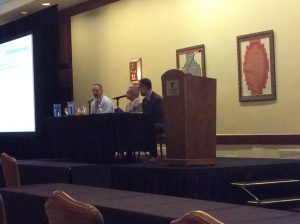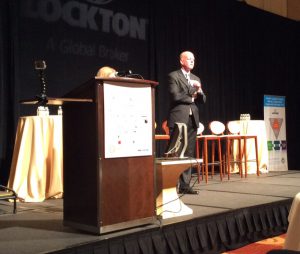Where Wellness and Workers’ Comp Intersect
There is growing consensus that a healthier workforce can not only reduce injuries but also reduce duration of disability and severity of injuries. A panel at the 2016 SIIA Workers’ Compensation Executive Forum discussed how a higher focus on employee wellness can impact your workers’ compensation program. The panel was: Brian Carpenter – Clinical Director, Optum Kevin Confetti – Deputy Chief Risk Officer, University of California Mark Pew – Senior Vice President, PRIUM There have been conflicting studies around the overall effectiveness of a wellness program. Some studies show significant return on investment for these programs, while others show the
(Read the full article…)
SIIA 2016 Workers’ Compensation Executive Forum
Conference Chronicles will be blogging from SIIA’s Annual Self-Insured Workers’ Compensation Executive Forum on May 24-25, 2016, in Scottsdale, Arizona. This conference is dedicated exclusively to the topic of self-insured workers’ compensation, with a strong educational program focusing on such topics as excess insurance and risk management strategies. Learn more about SIIA’s Annual Self-Insured Workers’ Compensation Executive Forum here.
Traumatic Brain Injuries
At the 2016 Lockton Complex Risk Symposium in St Louis, David Ripley MD from Rehabilitation Institute of Chicago discussed the dynamics of a brain injury from diagnosis through rehabilitation. It is estimated that there are 2-5 million brain injuries per year. This is a big range because often many people do not realize they suffered an injury and never seek medical treatment. Many of us have experienced getting struck in the head and being temporarily dazed. About 52,000 deaths per year are attributed to traumatic train injuries. The leading cause of brain injury used to be motor vehicle accidents but
(Read the full article…)
Predictive Claims Models
At the 2016 Lockton Complex Risk Symposium in St Louis, a panel discussed the use of predictive claim models. The panel was: Mark Moitoso – SVP Analytics Practice Leader, Lockton Gary Anderberg – SVP Claim Analytics, Gallagher Bassett JJ Schmidt – SVP Managed Care, York Risk Services Melissa Dunn – VP and Managing Director, Helmsman Management Services Christopher Makuc – Liability Estimation and Insurance Coverage Analysis – Navigant What does big data really mean? Big data refers to a real phenomenon where we can examine more data points than we have ever been able to do in the past. Modeling
(Read the full article…)
Digital Transformation
At the 2016 Lockton Complex Risk Symposium, Fredi Lienhardt from Swiss Re gave an overview of current innovative trends in digital transformation. Internet of Things The Internet of Things (IoT) is transforming life as we know it. This includes any of a wide variety of wearables and sensors on devices we use every day. Examples include: A FitBit or Apple Watch that monitors our activity levels. Medical monitoring systems that operate independently such as insulin pumps. IoT uses in the medical field show great promise in ensuring patients are taking medications properly, performing therapeutic exercises, etc. Vehicles use IoT to
(Read the full article…)
Managing Workplace Violence
At the 2016 Lockton Complex Risk Symposium, Denise Balan from XL Catlin and Heyrick Bond Gunning from S-RM discussed workplace violence and how risk managers in reducing the incidences of this. OSHA defines workplace violence as any act or threat of physical violence, harassment, intimidation or other threatening disruptive behavior that occurs at the work site. Homicide is the 4th leading cause of death in the workplace and the leading cause of death for women in the workplace. There were over 700 deaths due to workplace violence last year. Categories of workplace violence include: robbery customers clients and patients employees
(Read the full article…)
NCCI Regulatory and Legislative Trends
At the 2016 NCCI Annual Issues Symposium, Lori Lovgren and Ann Bok from NCCI compiled a report with some interesting statistics about trends in the workers’ compensation industry. The highlights: Between January 1, 2015 and March 5, 2016, NCCI monitored 660 pieces of proposed legislation impacting workers’ compensation from around the country. The key workers’ compensation related topics seen were first responder presumptions, definition of employee and independent contractors, medical cost management, exclusive remedy, and opt out. In the last year, two states passed drug formularies for workers’ compensation (Tennessee, California). Regulation to consider formularies was introduced in Nebraska, Louisiana,
(Read the full article…)
NCCI State of the Line report
At the 2016 NCCI Annual Issues Symposium, NCCI Chief Actuary Kathy Antonello presented their annual State of the Line Report. The entire State of the Line report can be viewed on the NCCI web site (NCCI.com). Some of the highlights: Total Property Casualty premiums increased 3.3% in 2015. All lines except Fire and Allied Lines had premium increases. Workers’ compensation premiums increased 2.9%. Total workers’ compensation industry premiums were $39.7 billion. This does not include state funds. Combined ratios for the workers’ compensation industry in 2015 were 94%. This is the best underwriting results the industry has seen in decades.
(Read the full article…)
Opening session at NCCI Annual Issues Symposium
NCCI President and CEO Bill Donnell kicked off the 2016 NCCI Annual Issues symposium with his observations of the workers compensation industry. The theme for NCCI AIS this year is Channeling Change: Meeting the Challenges of an Evolving Market. Bill is the new CEO of NCCI this year so he started with some observations from his first year on the job. He feels the mandate for NCCI today is essentially unchanged for the last 100 years. NCCI provides independent, objective analysis that assists workers’ compensation industry stakeholders. He emphasized the critical role they play including providing analysis for over 100
(Read the full article…)
Impact of Autonomous Vehicles and On-Demand Economy
At 2016 Philly I Day, a presentation discussed how the combination of on-demand transportation services and autonomous vehicles could impact the risk landscape in the future. The speakers were: Gerald Finley – SVP Casualty Treaty Underwriting, Munich Reinsurance America, Inc. Martin Frappolli – Senior Director of Knowledge Resources, The Institutes There are different levels of vehicle autonomy ranging from 0-4 depending on the number of autonomous features it has. Level Zero vehicles no longer exist. All cars have some form of autonomy such as cruise control, or anti-lock brakes. A Level 4 vehicle is truly autonomous with no human control
(Read the full article…)











